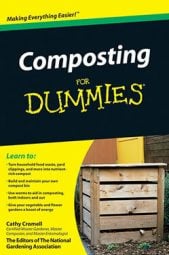Your compost pile is a food web, containing groups of ever-larger inhabitants consuming plant material and each other. Together, they take your kitchen scraps and manure and other stuff and transform it into wonderfully rich growing material. The major players are the chemical decomposers and the physical decomposers.
Chemical decomposers
Four specific microbes are involved in chemical decomposition in your compost pile:
Bacteria: These single-celled organisms are the most numerous chemical decomposers working your pile. The types and numbers of bacteria vary with each pile you construct. The more variety in your ingredients, the more variety in your decomposers. Different bacteria thrive at different temperature ranges.
Actinomycetes: As bacteria populations consume all the easy-to-break-down compounds, such as simple sugars, actinomycetes take over to work on complex organic materials, such as bark and fibrous or woody stems.
Fungi: Fungi in your compost pile break down tough organic matter that earlier rounds of decomposers leave behind, such as dry, acidic, or high-carbon materials. Most fungi require less nitrogen than bacteria do, so fungi are important decomposers in piles with high-carbon materials, such as wood chips or sawdust.
Protozoa: Like bacteria, protozoa are microscopic, one-celled organisms that appear as primary and secondary consumers in your compost.
Physical decomposers
Many physical decomposers, such as beetles and millipedes, are large enough to easily spot from above. Others, such as mites and springtails, are tiny, although still visible with the naked eye if you scoop up a handful of compost and peer closely.
Nematodes (roundworms): In your compost pile, nematodes (roundworms) consume decaying plant material and eat other decomposers, such as bacteria and fungi.
Mites: Although spider mites are notable garden pests, many beneficial mites help degrade organic matter in your compost pile. For example, mold mites feed primarily on yeasts in organic debris.
Springtails: These intriguing little wingless insects measure from 1/16 inch up to 1/4 inch in length. They are beneficial occupants of your compost pile, chewing on decomposing plant matter, grains, bacteria, fungi, algae, pollen, and even insect feces. Springtails are highly susceptible to drying out. Thus, you'll most likely spy them in the moister environs of your compost pile.
Sowbugs and pillbugs: Very similar in appearance, these terrestrial crustaceans breathe with gills, so they require living accommodations.
Millipedes and centipedes: Millipedes feed on moist decaying plant matter, helping break down the contents of your compost pile. However, centipedes feed only on living creatures, especially insects and insect larvae, and may use your compost pile as a hunting ground.
Centipede bites can be painful, although they're not usually life threatening unless the victim has allergic reactions or is a small child. If you have a bad reaction to a bite, consult your physician or poison control center immediately.
Beetles: Numerous beetle species operate throughout your compost pile, both during their larval life stage and as adult beetles. Grubs feed on rotting organic matter. Beetles may consume organic matter but also seek prey such as fly larvae (maggots), mites, and nematodes.
Snails and slugs: You may choose to destroy snails and slugs because if they still reside in the finished compost when you spread it around your garden, you've just given them a free pass to the head of the buffet line.
Ants: Most ants are beneficial in a compost pile, eating all kinds of stuff, including fungi, food scraps, seeds, and even other ants. They also help develop richer compost by transporting important minerals such as phosphorous and potassium from one area to another.
Flies: Adult flies feed on organic material and deposit their eggs in compost piles to provide a ready food source for hatching larvae (maggots). Maggots, in turn, are eaten by mites and other creatures, so it's all part of the food web.
Earthworms: Earthworms are the ultimate composting machines, consuming and digesting organic matter to deposit their rich waste.

